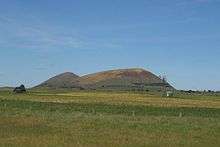Mount Elephant

Mount Elephant is a 240-metre-high (790 ft) conical breached scoria cone formed by a dormant volcano, located 1 km from the town of Derrinallum in southwestern Victoria, Australia. It is a prominent landmark that forms the eastern gateway to the Kanawinka Geopark from the Hamilton Highway at Derrinallum.
Formation and history
Scoria cones are small volcanoes with relatively steep sides, usually formed as the result of a single major episode of volcanic activity. Lava lakes often form in the centre of scoria cones; if the lava in such a lake breaches the side of the cone, the result is a breached scoria cone, such as Mount Elephant. There are approximately 200 breached scoria cones in Victoria.
Mount Elephant was once quarried for its red/black scoria, and evidence of the quarry is visible at the base of its cone. The scoria that was quarried from Mount Elephant was used to make many of the roads and buildings in and around the town of Derrinallum.
The volcano is thought to have last erupted between 5,000 and 20,000 years ago making Mount Elephant dormant. During early European settlement, the mountain was known as Swagman's Lighthouse. The mountain was privately owned until 2000, when it was purchased by the Trust for Nature and the local community. The aim is to revegetate the area and promote local tourism.
In Aboriginal life
In the nineteenth century, an Aboriginal name for Mount Elephant, Gerinyelam, was recorded by a colonist.[1]
During European colonization in 1830s, Mount Elephant was located within the territory of a Djargurd Wurrung clan, Teerinyillum gundidj.[2]
According to James Dawson, "The Mount Shadwell tribe and its language are called 'Kirae wuurong,' 'blood lip' with Kuurndit ["member of"] affixed for a member of the tribe. Its territory commences at the Hopkins Hill sheepwash on the Hopkins River, and extends to Mount Fyans, Mount Elephant, Cloven Hills, Minninguurt, Mount Noorat, Keilambete Lake, Framlingham aboriginal station, and up the east side of the Hopkins River to starting point."[3]
The photographer, Fred Kruger (1831-1888) took a photograph of King Tom, a survivor of the "Mount Elephant Tribe", at Coranderrk Settlement in the Yarra Valley (see Board for protection of Aborigines Album No. 131, Museum of Victoria.). King Tom lived at Meningoort Station, about 25 km south-west of Mount Elephant, north of Camperdown and west of Lake Bookaar. His mia-mia was near the homestead, and was painted by Robert Dowling in 1856. The painting, entitled "Aborigines in a bark hut: King Tom of the Mount Elephant tribe", is in the collection of the National Library of Australia.[4] Meningoort Station still exists in Corangamite Shire and has remained in the McArthur family since Scottish immigrant, Peter McArthur, squatted on the land in 1837.[5]
According to the Trust for Nature, "Even well before early European settlement, the local Indigenous community, the Djerrinallum gundidj, reputedly knew Mount Elephant as Djerrinallum – meaning 'Hill of Fire'. With their presence and a local history dating back as far as 45,000 years the Indigenous peoples of the area will certainly have witnessed a few of the eruptions in the region, including Mount Elephant. Therefore, it is of little wonder that some feature prominently in local Dreaming stories."[6]
See also
References
- ↑ Smyth, Robert Brough (1878). The Aborigines of Australia: With Notes Relating to the Habits of the Natives of Other Parts of Australia and Tasmania. Vol. 2. London: John Ferres. p. 179. Retrieved 3 July 2013.
- ↑ Ian Clark (1995) Scars In The Landscape: A Register of Massacre Sites In Western Victoria, 1803-1859, Aboriginal Studies Press for Australian Institute of Aboriginal and Torres Strait Islander Studies, p.105
- ↑ Dawson, James (1900). Australian Aborigines: The Languages and Customs of Several Tribes of Aborigines in the Western District of Victoria, Australia (2nd ed.). Melbourne: George Robertson. p. 2. Retrieved 3 July 2013.
- ↑ See National Library of Australia - Trove, retrieved on 4 July 2013, http://trove.nla.gov.au/work/167558734?q=elephant+Tom&c=picture&versionId=182621557
- ↑ See "Meningoort Homestead (Heritage Listed Location) on http://www.onmydoorstep.com.au/heritage-listing/193/meningoort-homestead, retrieved 4 July 2013.
- ↑ Trust for Nature, "Mount Elephant – Impressions Then and Now", Conservation Bulletin No. 53 (1 September 2011), p. 10.
External links
- Mount Elephant, Derrinallum, Revisited
- Kanawinka Geopark, Victoria & South Australia
- Derrinallum, Revisited
- New site for Mount Elephant Community Management Inc.
| ||||||||||||||||||||||||||||||||||||||||||||||||||
Coordinates: 37°57′40″S 143°11′53″E / 37.961°S 143.198°E